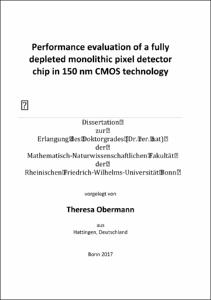Performance evaluation of a fully depleted monolithic pixel detector chip in 150 nm CMOS technology

Performance evaluation of a fully depleted monolithic pixel detector chip in 150 nm CMOS technology

| dc.contributor.advisor | Wermes, Norbert | |
| dc.contributor.author | Obermann, Theresa | |
| dc.date.accessioned | 2020-04-23T23:48:11Z | |
| dc.date.available | 2020-04-23T23:48:11Z | |
| dc.date.issued | 01.09.2017 | |
| dc.identifier.uri | https://hdl.handle.net/20.500.11811/7206 | |
| dc.description.abstract | The depleted monolithic active pixel sensor (DMAPS) is a new concept integrating full CMOS circuitry onto a (fully) depletable silicon substrate wafer. The realization of prototypes of the DMAPS concept relies on the availability of multiple well CMOS processes and highly resistive substrates. The CMOS foundry ESPROS Photonics offers both and was chosen for prototyping. Two prototypes, EPCB01 and EPCB02, developed in a 150 nm process on a highly resistive n-type wafer of 50 µm thickness, were characterized. The prototypes have 352 square pixels of 40 µm pitch and a small n-well charge collection node with very low capacitance of 5 fF (n+-implantation size: 5 µm x 5 µm) and about 150 transistors per pixel (CSA and discriminator plus a small digital part). The characterization of the prototypes demonstrates the proof of principle of the concept. Prior to irradiation the prototypes show a signal from a minimum ionizing particle ranging from 2400 e- to 3000 e- while the noise is 30 e- due to the low capacitance. After the irradiation of the prototypes with neutrons up to a fluence of 5•1014 neutrons/cm2 the performance suffers from the radiation damage leading to a signal of 1000 e- and a higher noise of 60 e- due to the increase of the leakage current. The detection efficiency of the prototypes reduces from 94 % to 26 % after the fluence of 5•1014 particles/cm2. Due to the small fill factor the detection efficiency shows are strong dependence on the position within the pixel after irradiation. Thus the DMAPS concept with low fill factor can be used for precise vertex reconstruction in High Energy Physics experiments without severe performance loss up to moderate fluences (< 1•1014 particles/cm2). The expected particle fluences inside of the volume of the upgrade of the ATLAS pixel detector exceed this limit. However, possible applications could be at future linear collider (ILC or CLIC) experiments and B-factories where the low material budget is of particular importance and the fluences are much less and X-ray imaging with low energy photons which would benefit from the good noise performance. | en |
| dc.language.iso | eng | |
| dc.rights | In Copyright | |
| dc.rights.uri | http://rightsstatements.org/vocab/InC/1.0/ | |
| dc.subject | Pixeldetektor | |
| dc.subject | Silizium | |
| dc.subject | Tracking | |
| dc.subject | Strahlenhärte | |
| dc.subject | Charakterisierung | |
| dc.subject | Solid state detector | |
| dc.subject | Radiation tolerance | |
| dc.subject | Pixel detector | |
| dc.subject | Characterization | |
| dc.subject.ddc | 530 Physik | |
| dc.title | Performance evaluation of a fully depleted monolithic pixel detector chip in 150 nm CMOS technology | |
| dc.type | Dissertation oder Habilitation | |
| dc.publisher.name | Universitäts- und Landesbibliothek Bonn | |
| dc.publisher.location | Bonn | |
| dc.rights.accessRights | openAccess | |
| dc.identifier.urn | https://nbn-resolving.org/urn:nbn:de:hbz:5n-47784 | |
| ulbbn.pubtype | Erstveröffentlichung | |
| ulbbnediss.affiliation.name | Rheinische Friedrich-Wilhelms-Universität Bonn | |
| ulbbnediss.affiliation.location | Bonn | |
| ulbbnediss.thesis.level | Dissertation | |
| ulbbnediss.dissID | 4778 | |
| ulbbnediss.date.accepted | 09.06.2017 | |
| ulbbnediss.institute | Mathematisch-Naturwissenschaftliche Fakultät : Fachgruppe Physik/Astronomie / Physikalisches Institut (PI) | |
| ulbbnediss.fakultaet | Mathematisch-Naturwissenschaftliche Fakultät | |
| dc.contributor.coReferee | Desch, Klaus |
Dateien zu dieser Ressource
Das Dokument erscheint in:
-
E-Dissertationen (4337)




